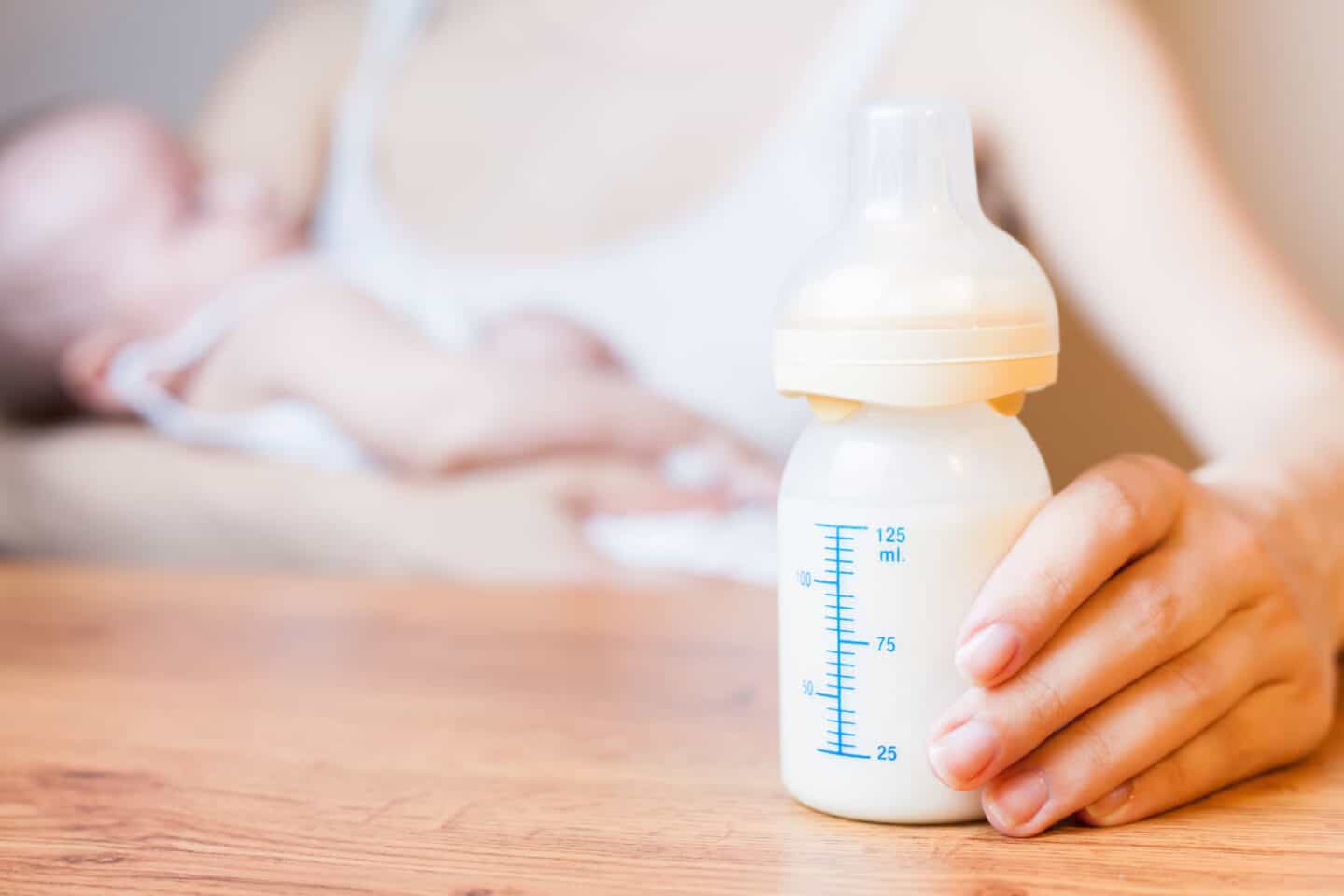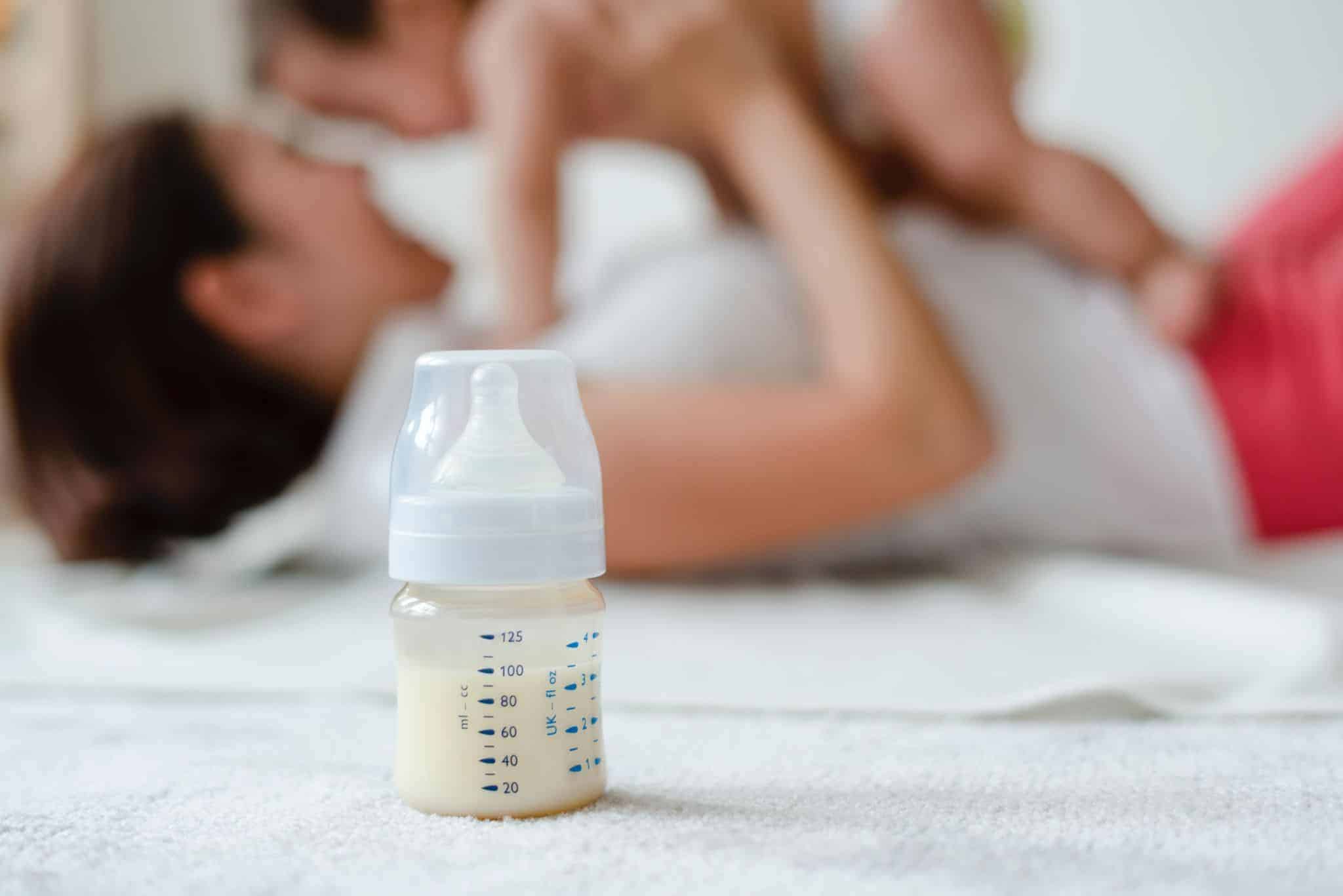Maybe you’re pregnant right now and you’re thinking about breast pumping exclusively from birth.
You are probably trying to figure out all the things you need to make the whole thing as smooth as possible.
You may be worried about everything!
From how you’re going to manage to pump in the Delivery room or how it’s going to work out in your own home.
It can definitely be a challenge!
I get it, I’ve been there too.
I pumped exclusively with my first child and I still remember a thousand questions going off in my mind.
To be honest, I had no idea what I was doing back then and I don’t want you to go through the same that’s why in this post I’ll share everything I learned to put your mind at rest.

As an Amazon Associate I earn from qualifying purchases. The links below may be affiliate links. Please read my disclosure policy for more information.
What You’ll Need To Get Started
When I had my first baby I didn’t plan on pumping until I went back to work. Because I wanted to solely breastfeed I didn’t buy any pumping equipment beforehand.
To me, it didn’t make sense to waste money buying everything so soon; we all know how expensive breast pump can be.
If you’re set on pumping exclusively from birth you’ll need to prepare and buy some pumping gear before your little one arrives.
Here’s a list of my recommended essential items:
Take a breastfeeding course
One thing I would really recommend is taking the Milkology online breastfeeding class. It really is an invaluable investment and will give you all the information and confidence to go ahead and be able to breastfeed confidently. I wish this course had been available when I had my first child.
The best thing, however, is if you use the mamaoffive milkology coupon code 10DISCOUNT you will get 10% off.
Hands Down The Best Online Breastfeeding Class Ever
A double Electric Breast-Pump
Of course, it’s possible to pump with a single electric or manual pump but it’ll take more time and it’ll be way harder.
With a double pump, both of your breasts will be supplying milk helping to avoid any milk loss.

A Hands-Free Pumping Bra
Having a hands free pumping bra is definitely more for convenience than anything else. It allows you to do some multitasking instead of holding your baby and getting backaches while pumping.
It may not be a crucial item but it makes so much easier in the first few weeks and thereafter, so for me is a total must-have.

Bottles to Pump Into
Every time you pump you’ll need at least two bottles so it’s extra helpful to have an extra set of ready-to-go bottles when you’re pumping up to eight times a day.
This way you won’t have to constantly wash things up all the time and wasting a much-needed bonding-time with your baby.

Get To Know Your Breast Pump Before Your Baby Is Born.
You don’t want to be completely clueless when it’s time for the real deal.
Don’t wait around to the last minute to figure out how to use your pump.
While you’re pregnant you’ll have enough time to learn how to manoeuvre it and get comfortable using it. Take out of its packaging, clean, sanitize all the parts and set everything up.
There’s no better time to buy your pump while you’re pregnant. If you haven’t already, hurry up.
Collect Colostrum
Please, never begin pumping without consulting your doctor first. It can lead to early labor, therefore, it’s extremely important to do it correctly following your doctor advice.
Colostrum is what you produce for the first time a few days before regular milk comes in. It’s thick and yellow, so don’t worry because it’s very easy to identify it.
You can actually collect it if you’re prone to leaking.
I used these 1ml syringes to collect colostrum, as I was leaking during my pregnancy.
Immediately pump after birth
Once you’re in labor at the hospital the medical staff will ask you whether you plan on breastfeeding your baby.
This can feel like you’re put on the spot because maybe you’re still not sure and you keep going back and forth.
It’s okay if you feel taken aback, when they ask you, especially if you’re mid-way through pushing.
So, maybe it’s wise to plan ahead.
If you’re both doing well after a vaginal birth you’ll be offered to nurse your new-born.
But, if your baby needs special care due to a C-section or premature birth, unfortunately, you won’t be able to choose.
You have the choice to either do a nursing session or completely decline and plan to pump when you get into the recovery room or the hospitals assigned area.

Let the staff know your plan to breastfeed in advance so you’re able to pump while you’re in the recovery room.
Pumping While in Recovery
Pumping in a hospital room can be scary and it can also bring all sort of anxieties, especially because it’s probably your first time doing it in a more public space.
But don’t worry; here is some of my advice on the topic.
How To Pump While You’re Recovering.
- You should be able to get a breast pump from the hospital while you’re in – the recovery room. You’ll be able to use it for as long as you stay there.
- A great time saver that can help out to avoid any issues is to check with your hospital beforehand to ensure they will provide you with one or you can also just bring your own pump as a back-up.
- Ideally, with a new-born, you will want to pump as often as your baby eats, which can be about every three hours.
All of my kids have been amazing sleepers from the get-go and after birth, they’d crash out for 24 hours which I found was way too long not to pump. It’s okay to go over the three hours time window for the first day if you need to rest after childbirth. Just try not to wait too long.
At The Hospital: Tips
- You might still be confused about what to do with all the pump parts which will come in a sterile bag- when the nurse hands them to you. It’s totally normal, so don’t hesitate to ask for help assembling the whole thing because you’ll want to get all the pump’s pieces set up properly or it might not work correctly.
- Most hospitals will store your milk for you if you’re able to pump and your baby isn’t ready to eat yet. Pro-tip? Just ask the hospital staff to label it.
- The medical staff might want you to wash the pump parts between uses if so ask them how to do it, especially if you’re new to pumping. To avoid washing directly in the sink, they probably will have a basin you can use just for that.
When your baby is ready to eat then you can feed it to him or her, it’ll be especially good if you’re able to pump some colostrum.
Also, keep in mind that once in the hospital you might have to supplement with formula.
Colostrum
You can experience a hard time pumping colostrum.
For instance, I did and so many other women struggle with the same issue as well.
It’s really common so there’s no need to worry about it.
When I was in the hospital I never managed to get more than a few millimetres. It wasn’t until my paediatrician came along and told me that I was producing a very small amount.
Don’t feel Defeated
It can be disheartening. I didn’t think I was ever going to breastfeed because of my low-level colostrum, but as soon as you see your breasts pour with milk, you’ll be motivated again.
YOU MAY ALSO LIKE:
Are You making these breast pumping mistakes?
Formula is Always An Option
If your baby is still hungry and the colostrum you pump just isn’t enough then the best option would be to formula-feed until your milk comes in.
Going Home With Your Newborn
Within 2-4 days after you give birth, your milk supply should be in full swing.
It should be obvious when this happens, considering you’ll be pumping.
You might find that you’ll go from just a few drops of milk to a few ounces by the next pumping session. It’s definitely a big and noticeable difference.

Create a pumping schedule as soon as you get home.
In my case, I was pumping every time my baby ate.
Although some women prefer to have set times so they are able to work around it.
Try not to skip any pumping sessions.
I religiously pumped around the clock and found 4 am to be the time when I produced the most milk.
If you notice that you’ve got an oversupply in the first few weeks, you may want to speak to a lactation consultant.
RELATED: HOW TO BOTTLEFEED A BREASTFED BABY
Try Not To Miss Any Sessions
But from my experience missing pumping sessions, it’s not a good idea. You may go down in supply once it’s regulated again and you can find it difficult to keep up with a demanding baby.
You’ll be working hard to get that supply back.
Make sure you are all in about exclusively breast pumping from birth
I would definitely recommend being sure about exclusively pumping.
RELATED: HOW TO PUMP WHILE BREASTFEEDING

Sure. It’s a big decision to exclusively pump, mainly because your baby might not feel like cooperating if you decide you’d rather nurse later on.
Many babies refuse the bottle when moms nurse during their maternity leave and then go back to their work schedule. The same thing applies if the baby is used to only-bottle feeding.
That’s the thing about babies; they’re smart!
And they’ll refuse to be fed in a different way to the one they’ve grown to like better.
There are tons of good reasons to go for the ‘exclusively-breastfeed’ method from birth.
RELATED:
Storing Breast Milk (With Freezing and Thawing) in the Correct Way
How to cope if you have a toddler
Toddlers suddenly become much clingier when you have a newborn, or maybe you notice it more because you have a newborn.
If you are planning on exclusively pumping from birth then I would suggest planning some activities to keep your toddler busy.
while you are pregnant start putting into place activities that your toddler can do independently such as a Magna doodle, blocks, noisy puzzles and books.
I used to put these into a few boxes and rotate them so my toddler was never bored. This gave me the opportunity to pump.
I would always involve my toddler in sitting with me while I was feeding the baby expressed milk and talk to him so he didn’t feel left out.
Still Not Sure?
If you’re still on the fence about it, my advice would be to try nursing first.
When I only had one baby pumping was easier but as I went on to have more children. I found breastfeeding easier than exclusively-pumping with 5 children.
Just make sure whatever you choose to do is the right decision for you.






